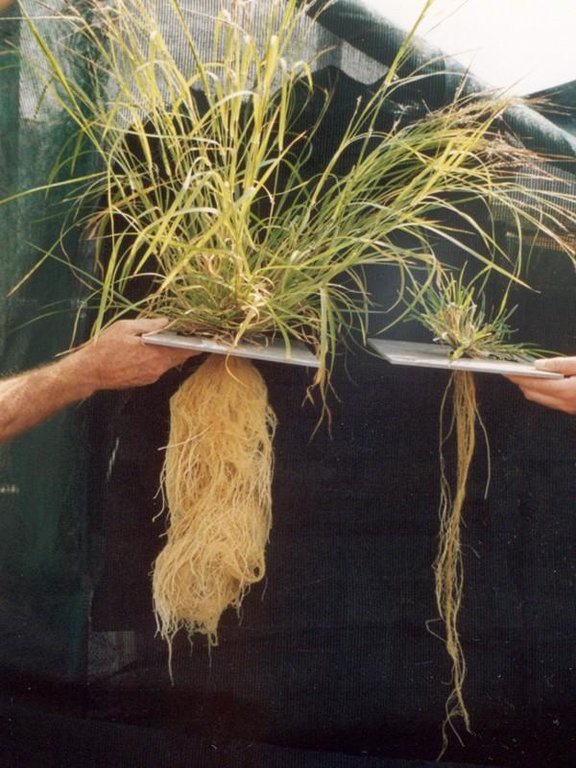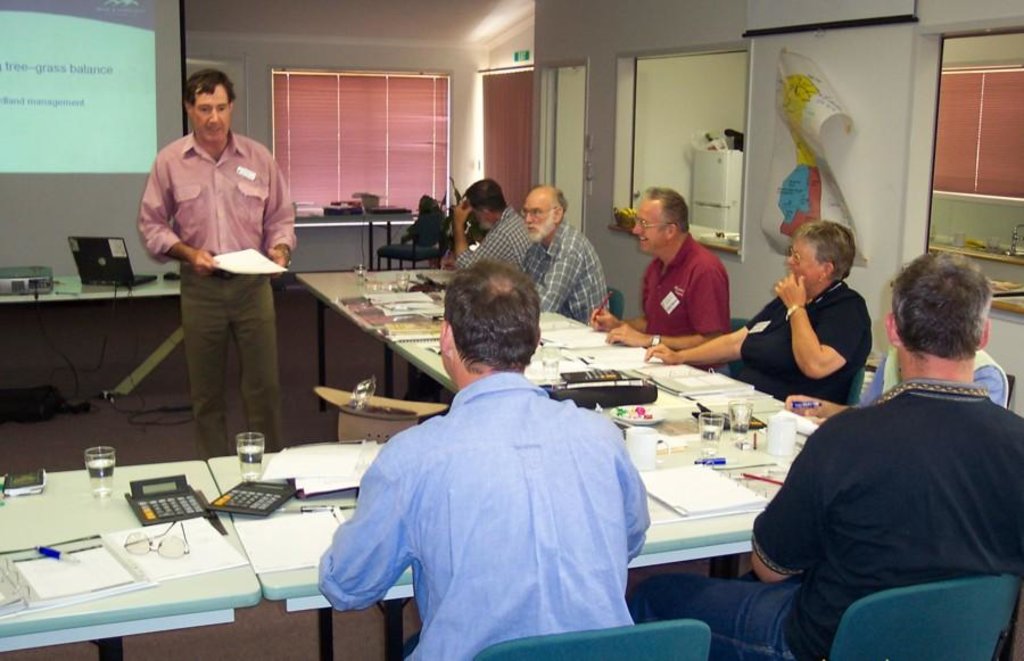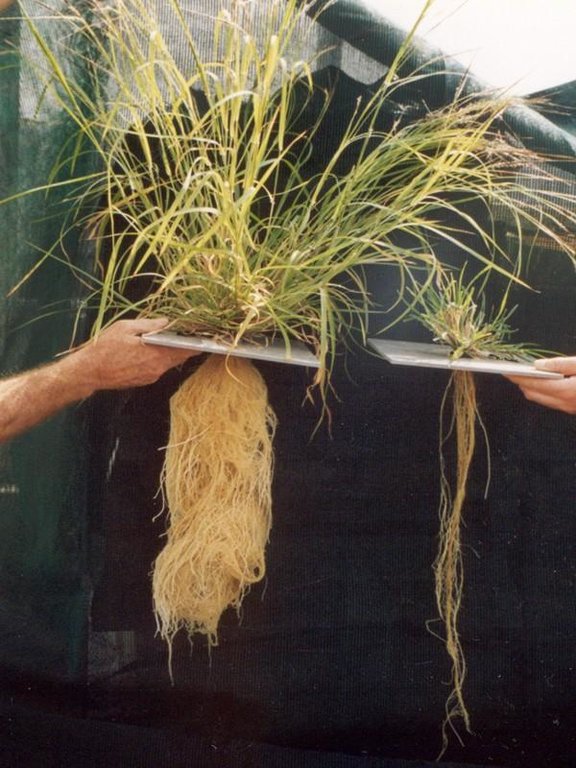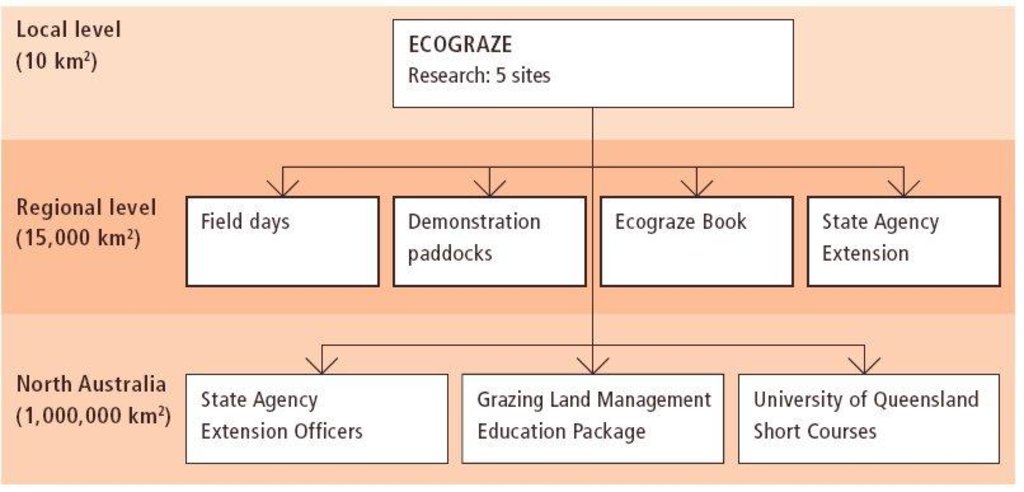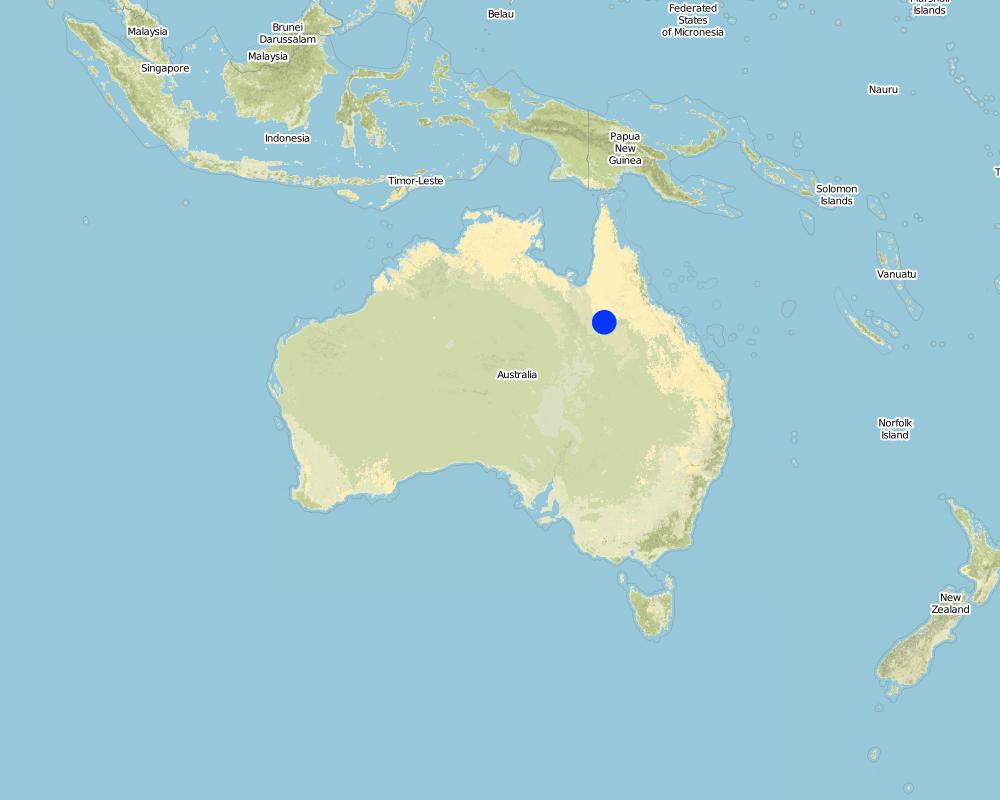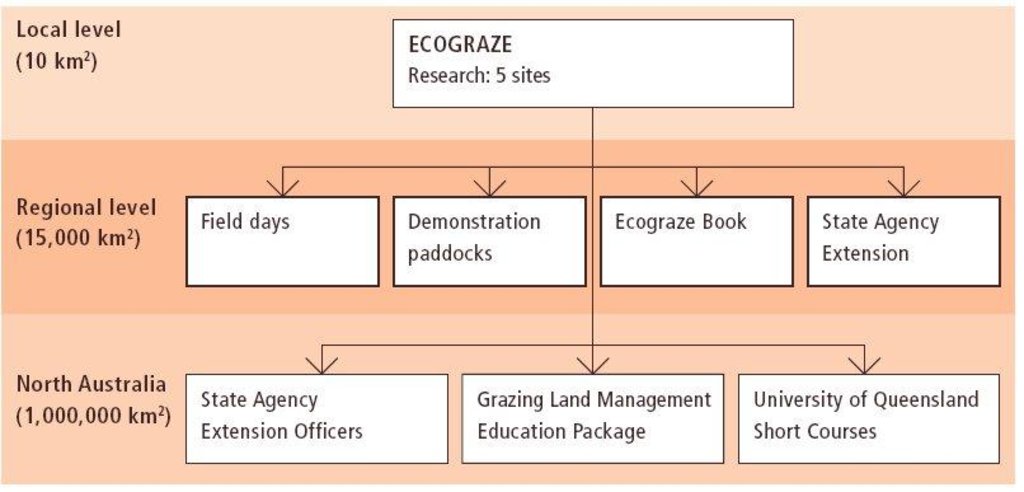Development and promotion of Ecograze [ອອດສະເຕເລຍ]
- ການສ້າງ:
- ປັບປູງ:
- ຜູ້ສັງລວມຂໍ້ມູນ: Andrew Ash
- ບັນນາທິການ: –
- ຜູ້ທົບທວນຄືນ: David Streiff, Deborah Niggli
approaches_2333 - ອອດສະເຕເລຍ
ເບິ່ງພາກສ່ວນ
ຂະຫຍາຍທັງໝົດ ຍຸບທັງໝົດ1. ຂໍ້ມູນທົ່ວໄປ
1.2 ລາຍລະອຽດ ການຕິດຕໍ່ ຂອງບຸກຄົນທີ່ຊັບພະຍາກອນ ແລະ ສະຖາບັນ ການມີສ່ວນຮ່ວມ ໃນການປະເມີນຜົນ ແລະ ເອກະສານ ຂອງວິທີທາງ
ຊື່ຂອງໂຄງການ ທີ່ອໍານວຍຄວາມສະດວກ ໃນການສ້າງເອກກະສານ ຫຼື ປະເມີນດ້ານແນວທາງ (ຖ້າກ່ຽວຂ້ອງ)
Book project: where the land is greener - Case Studies and Analysis of Soil and Water Conservation Initiatives Worldwide (where the land is greener)ຊື່ຂອງ ສະຖາບັນການຈັດຕັ້ງ ທີ່ອໍານວຍຄວາມສະດວກ ໃນການສ້າງເອກກະສານ ຫຼື ປະເມີນແນວທາງ (ຖ້າກ່ຽວຂ້ອງ)
CSIRO (CSIRO) - ອອດສະເຕເລຍ1.3 ເງື່ອນໄຂ ຂອງການນໍາໃຊ້ເອກກະສານຂໍ້ມູນ ຂອງ WOCAT
ຜູ້ສັງລວມ ແລະ ບັນດາຜູ້ຕອບແບບສອບຖາມ ຍອມຮັບໃນເງື່ອນໄຂ ການນໍາໃຊ້ຂໍ້ມູນເອກະສານ ທີ່ສ້າງຂື້ນ ໂດຍຜ່ານ ອົງການ WOCAT:
ແມ່ນ
1.4 ເອກະສານອ້າງອີງ (ຫຼາຍ) ກັບແບບສອບຖາມ (ຫຼາຍ) ເຕັກໂນໂລຢີ ຂອງດ້ານການຄຸ້ມຄອງ ດິນແບບຍືນຍົງ
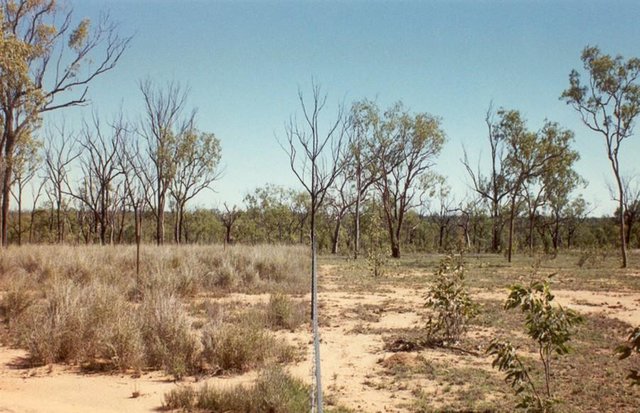
Ecograze [ອອດສະເຕເລຍ]
An ecologically sound and practical grazing management system, based on rotation and wet season resting.
- ຜູ້ສັງລວມຂໍ້ມູນ: Andrew Ash
2. ພັນລະນາ ແນວທາງການຄຸ້ມຄອງນໍາໃຊ້ດິນແບບຍືນຍົງ
2.1 ການອະທິບາຍ ໂດຍຫຍໍ້ ຂອງວິທີທາງ
Research-based development and promotion of Ecograze principles and practices through on-farm testing and demonstration.
2.2 ການອະທິບາຍ ລາຍລະອຽດ ຂອງວິທີທາງ
ການອະທິບາຍ ລາຍລະອຽດ ຂອງວິທີທາງ:
Aims / objectives: In 1992, Meat and Livestock Australia (MLA), a producer-owned company that provides services to the entire Australian red meat industry, initiated the Ecograze project. Ecograze was intended to provide innovative management options for the pastures in the eucalyptus woodlands of north-east Queensland. It was an eight-year collaborative research project undertaken by staff of the CSIRO (Commonwealth Scientific and Industrial Research Organisation) Sustainable Ecosystems and Queensland Department of Primary Industries with input from Queensland Department of Natural Resources and Mines. It formally concluded in 2001. However, many of the analyses and extension activities have been ongoing since then.
Methods: Ecograze was conducted on five commercial grazing properties that spanned different conditions and consequently allowed extrapolation of results to a much wider area across northern Australia. Practical grazing management strategies have been developed. The Ecograze team assessed the economic implications of managing land in various states by linking a pasture production model, to a model of farm economics. Research teams are currently testing the grazing management technology in commercial situations to understand the real costs and implications of implementing the research-derived Ecograze recommendations. The on-farm tests are supported by a number of new initiatives. These include a MLA funded project to specifically implement the Ecograze principles on farms as a means of reducing sediment and nutrients pollution of waterbodies. The National Action Plan for Salinity and Water Quality, through incentives, supports land management practices to reduce erosion, increase ground cover and minimise runoff. Funding is also provided by the Natural Heritage Trust to fence and sub-divide paddocks. All of these initiatives are supported by State Government agencies, who have extension staff based in the regions to assist farmers with implementing new practices. In the case of Ecograze, there are extension officers in the NE Queensland region who are actively promoting its management principles and are assisting producers in planning new strategies. Many of the Ecograze principles are also included in a new Grazing Land Management (GLM) Education package, developed by MLA and research and development agencies. The GLM package, which is delivered via a three-day workshop, is being extended to producers across northern Australia.
This approach highlights the importance of active collaboration between researchers, farmers, the beef industry and the government - in this case to develop a system to improve the condition of grazing lands. Through the central involvement of research, management options have been identified to suit different land users' needs, climates, grazing pressures and pasture conditions
2.3 ຮູບພາບຂອງແນວທາງ
2.5 ປະເທດ / ເຂດ / ສະຖານທີ່ບ່ອນທີ່ແນວທາງໄດ້ຖືກນໍາໃຊ້
ປະເທດ:
ອອດສະເຕເລຍ
ພາກພື້ນ / ລັດ / ແຂວງ:
Northern Australia
ຂໍ້ມູນເພີ່ມເຕີມຂອງສະຖານທີ່:
Queensland
Map
×2.6 ວັນທີເລີ່ມຕົ້ນ ແລະ ສິ້ນສຸດ ການຈັດຕັ້ງປະຕີບັດ ວິທີທາງ
ສະແດງປີຂອງການເລີ່ມຕົ້ນ:
1992
ປີທີ່ສີ້ນສູດ (ຖ້າຢຸດບໍ່ໄດ້ນໍາໃຊ້ ວິທີທາງ):
2001
2.7 ປະເພດຂອງແນວທາງ
- ພາຍໃຕ້ໂຄງການ / ແຜນງານ
2.8 ເປົ້າໝາຍ / ຈຸດປະສົງຫຼັກ ຂອງການຈັດຕັ້ງປະຕິບັດ ວິທີທາງ
The Approach focused on SLM only
Development and promotion of Ecograze principles leading to adoption and thereby enhancing pasture productivity, soil condition and improved livelihoods for pastoralists.
The SLM Approach addressed the following problems: (1) Poor rangeland management leading to loss of productive palatable perennial grasses (3 P grasses) resulting in reduced ground cover, soil erosion, profit loss and in some cases irreversible land degradation. (2) Lack of understanding of underlying problems regarding mismatch of animal numbers to forage supply (pressure on grazing land) in a highly variable climate. (3) No clear technical recommendations regarding resting and rotation of rangeland
2.9 ເງື່ອນໄຂອໍານວຍ ຫຼື ຂັດຂວາງການປະຕິບັດຂອງເຕັກໂນໂລຢີ / ເຕັກໂນໂລຢີການນໍາໃຊ້ຕາມແນວທາງ
ສັງຄົມ / ວັດທະນະທໍາ / ມາດຕະຖານ ແລະ ຄຸນຄ່າທາງສາສະໜາ
- ເຊື່ອງຊ້ອນ
Many pastoralists are conservative and change their systems only slowly.
Treatment through the SLM Approach: There are ongoing education programmes and demonstrations on target properties.
ມີຄວາມສາມາດ / ເຂັ້າເຖິງຊັບພະຍາກອນດ້ານການເງິນ ແລະ ການບໍລິການ
- ເຊື່ອງຊ້ອນ
Investment costs for fencing and water points can be burden on individual land holders.
Treatment through the SLM Approach: There are various possible subsidies available (see 'Inputs', under 'Incentives').
ກ່ຽວກັບກົດໝາຍ (ສິດນໍາໃຊ້ດິນ, ສິດນໍາໃຊ້ນໍ້າ)
- ອໍານວຍ
The existing land ownership, land use rights / water rights helped a little the approach implementation: In general, implementation of Ecograze principles is undertaken by an individual on private leasehold land. Ecograze is well suited to this individualised system.
3. ການມີສ່ວນຮ່ວມ ແລະ ບົດບາດຂອງພາກສ່ວນທີ່ກ່ຽວຂ້ອງທີ່ໄດ້ມີສ່ວນຮ່ວມ
3.1 ຜູ້ມີສ່ວນຮ່ວມ ໃນວິທີທາງ ແລະ ພາລະບົດບາດ ຂອງເຂົາເຈົ້າ
- ຜູ້ນໍາໃຊ້ດິນໃນທ້ອງຖິ່ນ / ຊຸມຊົນທ້ອງຖິ່ນ
Traditionally, men undertake on-farm planning, implementation of activities and provide labour. Women play an important role in planning and management of finances, and tend to take a more strategic view on NRM issues than the men.
- ພະນັກງານຂັ້ນສູນກາງ (ຜູ້ວາງແຜນ, ຜູ້ສ້າງນະໂຍບາຍ)
- Govt. agencies/extensionistes
3.2 ການມີສ່ວນຮ່ວມຂອງຜູ້ນໍາໃຊ້ທີ່ດິນໃນທ້ອງຖິ່ນ / ຊຸມຊົນທ້ອງຖິ່ນໃນໄລຍະທີ່ແຕກຕ່າງກັນຂອງແນວທາງ
| ການລວບລວມ ເອົາຜູ້ນໍາໃຊ້ດິນ ໃນທ້ອງຖິ່ນ / ຊຸມຊົນທ້ອງຖິ່ນ | ໃຫ້ລະບຸ ຜູ້ໃດທີ່ມີສ່ວນຮ່ວມ ໃນແຕ່ລະກິດຈະກໍາ? | |
|---|---|---|
| ການເລີ່ມຕົ້ນ / ແຮງຈູງໃຈ | ການບໍ່ປະຕິບັດ | workshops/seminars, field days |
| ການວາງແຜນ | ການນໍາໃໍຊ້ເອງ | consultation with specialists |
| ການປະຕິບັດ | ການນໍາໃໍຊ້ເອງ | fencing and water points |
| ຕິດຕາມກວດກາ / ການປະເມີນຜົນ | ການນໍາໃໍຊ້ເອງ | field observations; field observations of pasture composition; economic assessments |
| Research | ການຮ່ວມມື | on-farm; on-farm field trials and demonstration areas |
3.3 ແຜນວາດ (ຖ້າມີ)
ການອະທິບາຍ:
Programme organization: Components and activities at different levels of the Ecograze programme.
3.4 ການຕັດສິນໃຈກ່ຽວກັບການຄັດເລືອກເຕັກໂນໂລຢີຂອງການຄຸ້ມຄອງທີ່ດິນແບບຍືນຍົງ / ເຕັກໂນໂລຢີ
ລະບຸ ຄົນທີ່ຕັດສິນໃຈ ກ່ຽວກັບການຄັດເລືອກຂອງ ເຕັກໂນໂລຢີ / ເຕັກໂນໂລຢີ ຈະໄດ້ຮັບການປະຕິບັດ:
- ຜູ້ນໍາໃຊ້ທີ່ດິນຫຼັກ, ການສະໜັບສະໜູນ ໂດຍຜູ້ຊ່ຽວຊານ ການນໍາໃຊ້ທີ່ດິນແບບຍືນຍົງ
ອະທິບາຍ:
Mainly made by land users in consultation with technology experts and government agencies; recognition that Ecograze principles can benefit land users and the environment due to research results of field trials.
Decisions on the method of implementing the SLM Technology were made by by land users* alone (self-initiative / bottom-up). Mainly made by land users.
4. ການສະໜັບສະໜູນທາງດ້ານວິຊາການ, ການສ້າງຄວາມສາມາດ, ແລະ ການຈັດການຄວາມຮູ້.
4.1 ການສ້າງຄວາມສາມາດ / ການຝຶກອົບຮົມ
ຜູ້ນໍາໃຊ້ທີ່ດິນ ຫຼື ພາກສ່ວນກ່ຽວຂ້ອງອື່ນໆ ໄດ້ຮັບການຝຶກອົບຮົມບໍ່?
ແມ່ນ
ຮູບແບບຂອງການຝຶກອົບຮົມ:
- ຫຼັກສູດ
ໃນຫົວຂໍ້:
The Ecograze principles and findings have been incorporated into a training course entitled 'Grazing Land Management (GLM) Education Package'. To date (2005) over 100 farmers have participated in the course and it is anticipated that in the next three years this number will reach over 1,000 producers.
4.2 ການບໍລິການໃຫ້ຄໍາປຶກສາ
ເຮັດຜູ້ໃຊ້ທີ່ດິນມີການເຂົ້າເຖິງການບໍລິການໃຫ້ຄໍາປຶກສາ?
ແມ່ນ
ລະບຸວ່າການສະໜອງ ການບໍລິການ ໃຫ້ຄໍາປຶກສາ:
- ໃນພື້ນທີ່ຂອງຜູ້ນໍາໃຊ້ດິນ
- ສູນຄົ້ນຄວ້າ
ອະທິບາຍ / ຄວາມຄິດເຫັນ:
Key elements: In on-going research trials in cooperation with land-users, government officers build up their knowledge and capacity to support farmers . Field days form part of the extension and education process. , Government assistance with extension and training through free advice provided by extension officers is helpful, Subsidies to attend training courses like GLM Education also assist with the uptake and adoption of Ecograze. ; There is also a significant interaction between neighbouring properties in sharing of ideas and successes and failures. Commonly, these neighbouring properties are linked through catchment or a Landcare groups.
4.3 ສະຖາບັນການສ້າງຄວາມເຂັ້ມແຂງ (ການພັດທະນາອົງການຈັດຕັ້ງ)
ສະຖາບັນ ໄດ້ຮັບການສ້າງຕັ້ງຂື້ນ ຫຼື ໄດ້ຮັບການສ້າງຄວາມເຂັ້ມແຂງ ໂດຍການຈັດຕັ້ງປະຕິບັດ ວິທີທາງບໍ່?
- ມີ, ໜ້ອຍໜຶ່ງ
ລະບຸ ທາງສະຖາບັນ ໄດ້ສ້າງຄວາມເຂັ້ມແຂງ ໃນລະດັບໃດ (ຫຼາຍ):
- ທ້ອງຖິ່ນ
ລະບຸ ປະເພດ ຂອງສະໜັບສະໜູນ:
- ທາງດ້ານການເງິນ
ໃຫ້ລາຍລະອຽດເພີ່ມເຕີມ:
financial (see Annex A3)
4.4 ຕິດຕາມກວດກາ ແລະ ປະເມີນຜົນ
ການຈັດຕັ້ງປະຕິບັດ ວິທີທາງ ໄດ້ມີການປະເມີນຜົນ ແລະ ຕິດຕາມບໍ?
ແມ່ນ
ຄວາມຄິດເຫັນ:
Bio-physical aspects were regular monitored by 0 through measurements
Socio-cultural aspects were ad hoc monitored by land users through observations
Economic / production aspects were regular monitored by 0 through measurements;
Area treated aspects were ad hoc monitored by 0 through measurements
No. of land users involved aspects were ad hoc monitored by project staff through measurements
There were no changes in the Approach as a result of monitoring and evaluation: Further research and testing, on-going monitoring and evaluation is underway after the initial project. It is too early to state what changes are likely other than obviously needing to adapt to individual land-users resources and available finances.
4.5 ການຄົ້ນຄວ້າ
ນີ້້ແມ່ນສ່ວນໜຶ່ງ ການຄົ້ນຄວ້າ ຂອງວິທີທາງບໍ່?
ແມ່ນ
ລະບຸ ຫົວຂໍ້:
- ເສດຖະສາດ / ການຕະຫຼາດ
- ເຕັກໂນໂລຢີ
ໃຫ້ຂໍ້ມູນ ເພີ່ມເຕີມ ແລະ ກໍານົດ ຜູ້ໃດເຮັດການຄົ້ນຄວ້າ:
The impact of the ongoing research on understanding and implementing the technology through the Ecograze project is significant, and continues to be so. Research into various technical aspects of grazing management has been recently supplemented by economic analyses of costs and benefits.
5. ການສະໜັບສະໜູນທາງດ້ານການເງິນ ແລະ ອຸປະກອນຈາກພາຍນອກ
5.1 ງົບປະມານປະຈໍາປີ ສໍາລັບວິທີທາງ ຂອງການຄຸ້ມຄອງ ທີ່ດິນແບບຍືນຍົງ
ຄໍາເຫັນ (ຕົວຢ່າງ: ແຫຼ່ງຂໍ້ມູນຫຼັກ ຂອງການສະໜອງທຶນ / ຜູ້ໃຫ້ທຶນທີ່ສໍາຄັນ):
Approach costs were met by the following donors: government (national government): 40.0%; local community / land user(s) (community / local): 60.0%
5.2 ການສະໜັບສະໜູນ ທາງດ້ານການເງິນ / ອຸປະກອນ ສະໜອງໃຫ້ແກ່ຜູ້ນໍາທີ່ດິນ
ຜູ້ນໍາໃຊ້ດິນ ໄດ້ຮັບການສະໜັບສະໜູນ ທາງດ້ານ ການເງິນ / ອຸປະກອນ ໃນການຈັດຕັ້ງປະຕິບັດ ເຕັກໂນໂລຢີບໍ?
ແມ່ນ
ຖ້າແມ່ນ, ໃຫ້ລະບຸປະເພດ (ຫຼາຍ) ຂອງການສະໜັບສະໜູນ, ເງື່ອນໄຂ ແລະ ຜູູ້ສະໜອງ (ຫຼາຍ):
Local Landcare groups often request assistance, and this is provided either from the research agencies or from extension officers or through grant applications to the Natural Heritage Trust.
5.3 ເງິນສົມທົບສໍາລັບການນໍາໃຊ້ສະເພາະປັດໃຈຂາເຂົ້າໃນການຜະລີດກະສິກໍາ (ລວມທັງແຮງງານ)
- ບໍ່ມີ
ຖ້າແຮງງານ ຂອງຜູ້ນໍາໃຊ້ດິນ ໄດ້ຮັບການສະໜັບສະໜູນ ປັດໃຈຂາເຂົ້າ, ແມ່ນບໍ່:
- ການອາສາ
5.4 ສິນເຊື່ອ
ໄດ້ປ່ອຍສິນເຊື່ອ ສະໜອງໃຫ້ພາຍໃຕ້ ວິທີການສໍາລັບກິດຈະກໍາ ການຄຸ້ມຄອງ ທີ່ດິນແບບຍືນນຍົງບໍ່?
ບໍ່ແມ່ນ
5.5 ສິ່ງຈູງໃຈ ຫຼື ເຄື່ອງມືອື່ນໆ
ການສົ່ງເສີມ ຈັດຕັ້ງປະຕິບັດ ເຕັກໂນໂລຢີ ໃນການຄຸ້ມຄອງ ດິນແບບຍືນຍົງ ໄດ້ສະໜອງສິ່ງກະຕຸກຊຸກຍູ້ບໍ່?
ແມ່ນ
ຖ້າແມ່ນ, ໃຫ້ລະບຸ:
During the research phase of Ecograze, incentives were not available. However, since then, newly established Government initiatives such as the Natural Heritage Trust and the National Action Plan for Salinity and Water Quality, which commenced in 2003, have increased the number of incentives (eg support for on-ground works such as fencing, relocation of water points etc) available to implement management practices such as those recommended in Ecograze.
6. ວິເຄາະຜົນກະທົບ ແລະ ສັງລວມບັນຫາ
6.1 ຜົນກະທົບຂອງແນວທາງ
ການຈັດຕັ້ງປະຕິບັດ ວິທີທາງ ສາມາດຊ່ວຍຜູ້ນໍາໃຊ້ທີ່ດິນ ໃນການຈັດຕັ້ງປະຕິບັດ ແລະ ບໍາລຸງຮັກສາ ເຕັກໂນໂລຢີ ການຄຸ້ມຄອງ ທີ່ດິນແບບຍືນຍົງໄດ້ບໍ?
- ບໍ່
- ມີ, ໜ້ອຍໜຶ່ງ
- ມີ, ພໍສົມຄວນ
- ມີ, ຫຼາຍ
Ecograze leads to retention of 3P grasses ('perennial, productive and palatable' grasses), and therefore better pasture coverage, soil retention and greater water use efficiency.
Did other land users / projects adopt the Approach?
- ບໍ່
- ມີ, ໜ້ອຍໜຶ່ງ
- ມີ, ພໍສົມຄວນ
- ມີ, ຫຼາຍ
Ecograze principles have been included in the new Grazing Land Management Education package - which is being used across northern Australia by Meat and Livestock Australia and other agencies also. It has also now been incorporated into university courses on grazing management.
6.3 ຄວາມຍືນຍົງຂອງກິດຈະກໍາວິທີທາງ
ຜູ້ນໍາໃຊ້ ທີ່ດິນ ສາມາດສືບຕໍ່ ການຈັດຕັ້ງປະຕິບັດ ຜ່ານວິທີທາງໄດ້ບໍ່ (ໂດຍປາດສະຈາກ ການຊ່ວຍເຫຼືອ ຈາກພາກສ່ວນພາຍນອກ)?
- ແມ່ນ
ຖ້າ ໄດ້, ອະທິບາຍເຫດຜົນ:
Progress is continuing with further field trials and participation from land users. Those land users who have begun with the Ecograze system can continue without external support.
6.4 ຈຸດແຂງ / ຂໍ້ດີ ຂອງວິທີທາງ
| ຈຸດແຂງ / ຈຸດດີ / ໂອກາດ ຈາກທັດສະນະຂອງຜູ້ປ້ອນຂໍ້ມູນ ຫຼື ບຸກຄົນສຳຄັນ |
|---|
| Adoption of the technology should result in financial reward. (How to sustain/ enhance this strength: Continue ongoing economic analysis as an indication of technology success.) |
| The system has been very well documented and adapted to the land users conditions through the involvement of research, the land users, primary industry, and extension. (How to sustain/ enhance this strength: Continued support for applied/on-farm research to adapt the system to the needs of the land users and the environment. Support for long-term monitoring.) |
| State government extension agencies have also readily accepted Ecograze and are actively promoting its principles with landholders. |
| The approach is focussed on changing attitudes to management in the long term. (How to sustain/ enhance this strength: Continue with training and education programmes.) |
6.5 ຈຸດອ່ອນ / ຂໍ້ເສຍຂອງແນວທາງ ແລະ ວິທີການແກ້ໄຂໃຫ້ເຂົາເຈົ້າ
| ຈຸດອ່ອນ ຫຼື ຂໍ້ເສຍ ຫຼື ຄວາມສ່ຽງ ໃນມຸມມອງຂອງ ຜູ້ສັງລວມຂໍ້ມູນ ຫຼື ບັນດາຜູ້ຕອບແບບສອບຖາມ | ມີວິທີການແກ້ໄຂຄືແນວໃດ? |
|---|---|
| One-off training programs such as the Grazing Land Management Education package (a 3-day course) may not be enough to sustain initial commitment to testing new management options. | Create support network and supply follow-up training and/or support. |
7. ເອກກະສານອ້າງອີງ ແລະ ຂໍ້ມູນການເຊື່ອມໂຍງ
7.1 ວິທີການ / ແຫຼ່ງຂໍ້ມູນ
- ການໄປຢ້ຽມຢາມພາກສະໜາມ, ການສໍາຫຼວດພາກສະໜາມ
- ການສໍາພາດ ຜູ້ນໍາໃຊ້ທີ່ດິນ
7.2 ເອກະສານທົ່ວໄປທີ່ສາມາດໃຊ້ໄດ້
ຫົວຂໍ້, ຜູ້ຂຽນ, ປີ, ISBN:
Ash A, Corfield J and Taoufik T (undated) The ECOGRAZE Project: developing guidelines to better manage grazing country. CSIRO, Meat and Livestock Commission and Queensland Government
ຂໍ້ມູນການເຊື່ອມຕໍ່ ແລະ ເນື້ອໃນ
ຂະຫຍາຍທັງໝົດ ຍຸບທັງໝົດການເຊື່ອມຕໍ່

Ecograze [ອອດສະເຕເລຍ]
An ecologically sound and practical grazing management system, based on rotation and wet season resting.
- ຜູ້ສັງລວມຂໍ້ມູນ: Andrew Ash
ເນື້ອໃນ
ບໍ່ມີເນື້ອໃນ



